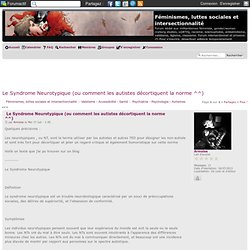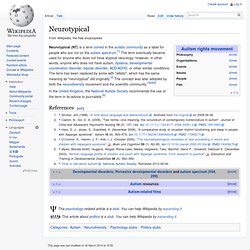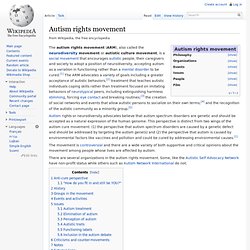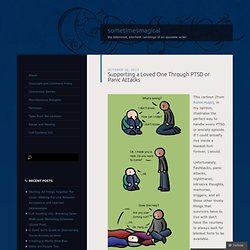

Les coeurs exacerbés » Existe-t-il une BD féminine? #2. Le Syndrome Neurotypique (ou comment les autistes décortiquent la norme ^^) Quelques précisions : Les neurotypiques , ou NT, sont le terme utiliser par les autistes et autres TED pour désigner les non-autiste et sont très fort pour décortiquer et jeter un regard critique et également humoristique sur cette norme Voilà un texte que j'ai pu trouver sur un blog Le Syndrome Neurotypique Définition Le syndrome neurotypique est un trouble neurobiologique caractérisé par un souci de préoccupations sociales, des délires de supériorité, et l'obsession de conformité.

Symptômes Les individus neurotypiques pensent souvent que leur expérience du monde est soit la seule ou la seule bonne. Causes Le NT est censé être d'origine génétique. Tendance Malheureusement, plus de 9 625 sur 10 000 personnes pourraient être neurotypique. Traitements Il n'existe pas de remède connu pour Neurotypic Disorder. Adaptation Dans de rares cas les NTs peuvent apprendre à compenser leur handicap et d'interagir normalement avec des personnes autistes.
Critères diagnostiques du Syndrome Neurotypique A. B. E. F. Neurotypical Privileges. Neurotypical. Neurotypical (NT) is a term coined in the autistic community as a label for people who are not on the autism spectrum.[1] The term eventually became used for anyone who does not have atypical neurology, however, in other words, anyone who does not have autism, dyslexia, developmental coordination disorder, bipolar disorder, ADD/ADHD, or other similar conditions.

The term has been replaced by some with "allistic", which has the same meaning as "neurotypical" did originally.[2] The concept was later adopted by both the neurodiversity movement and the scientific community.[3][4][5] In the United Kingdom, the National Autistic Society recommends the use of the term in its advice to journalists.[6] Autism rights movement. The autism rights movement (ARM), also called the neurodiversity movement or autistic culture movement, is a social movement that encourages autistic people, their caregivers and society to adopt a position of neurodiversity, accepting autism as a variation in functioning rather than a mental disorder to be cured.[1] The ARM advocates a variety of goals including a greater acceptance of autistic behaviors;[2] treatment that teaches autistic individuals coping skills rather than treatment focused on imitating behaviors of neurotypical peers, including extinguishing harmless stimming, forcing eye contact and breaking routines;[3] the creation of social networks and events that allow autistic persons to socialize on their own terms;[4] and the recognition of the autistic community as a minority group.[5] Autism rights or neurodiversity advocates believe that autism spectrum disorders are genetic and should be accepted as a natural expression of the human genome.

Anti-cure perspective[edit] "Advocacy", "Acceptance", "Awareness" Asperger. En janvier dernier j’ai été évaluée par le Centre de Ressources Autisme* de ma région pour confirmer (ou pas) le diagnostic du Dr Tuffreau dont je parle ici.

Il était temps que je vous raconte tout ça! J’ai passé différents tests : un test psychomoteur, un test d’intelligence (WAIS IV), l’ADOS (test spécifique à l’autisme), et un entretien avec un éducateur spécialisé pour évaluer mon degré d’autonomie dans différents domaines. J’ai été filmée pour le test psychomoteur et pour l’ADOS, après avoir donné mon autorisation. Une remarque cependant : les tests varient d’un CRA à l’autre. Certains CRA font même passer le test de Rorschach.
. « - Que voyez-vous ? - Un papillon - Et là ? - Et sur celle-ci ? - Hmmm. J’ai eu beaucoup de chance car dans ce CRA les personnes sont vraiment adorables, toutes sans exception, j’ai été très bien accueillie et mise en confiance dès le début. La WAIS est constituée de quatre items évalués par différentes tâches dont vous trouverez des exemples entre parenthèses : Supporting a Loved One Through PTSD or Panic Attacks.
This cartoon (from Robot Hugs), in my opinion, illustrates the perfect way to handle every PTSD or anxiety episode.

If I could actually live inside a blanket fort forever, I would. Unfortunately, flashbacks, panic attacks, nightmares, intrusive thoughts, memories, triggers, and all those other lovely things that survivors have to live with don’t have the courtesy to always wait for blanket forts to be available. It’s scary for the person experiencing the attack, but it’s also scary for any loved ones who are trying to comfort and support someone through an attack.
This post is for the supporters. Often in the midst of the episode, the distressed person doesn’t necessarily have their full vocabulary and can’t articulate exactly what they need in that moment. So how do you learn what is helpful? If you’re like my partner, mostly through trial and error. Safety Usually when someone is having an episode, they’re not actually in danger. Anchoring Touch (Use with extreme caution!) Recuperation Talk. WAVE Web Accessibility Tool.